A few updates, some rants and other observations of Delaware Roads – late 2006.
So much for the new “Delaware 141 Spur” being an actual spur. Instead the “Spur” is a relocated Delaware 141 mainline. Why is it so difficult to get the nomenclature right in the state of Delaware? If the road was an actual spur, it would not be considered the Delaware 141 mainline, especially with Delaware 141 North facing South at its end. But that is exactly how it is, despite little green street signs displaying “RT 141 Spur”. I investigated the new “interchange” with U.S. 202 and Delaware 261 on December 23 to see the results of several years of road work.
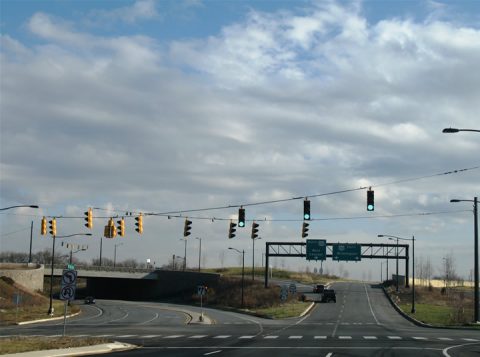
Delaware 141 now travels southeast from the intersection of Children’s Drive and Powder Mill Road over the former Rockland Road alignment to meet U.S. 202 and Delaware 261 (Foulk Road) at the new partial-interchange. Delaware 141 northbound faces southbound and enters the junction with U.S. 202 in this picture.
Interests to U.S. 202 north and south are now advised to take Delaware 141 north to this interchange, rather than remaining on Powder Mill Road east. Powder Mill Road is now simply signed as “nothing”, but it still is a better way to reach U.S. 202 north from Delaware 141 north in lieu of this southward detour. I don’t get why signs do not split interests to U.S. 202 north and south between the two roadways, but perhaps it was at the request of Astra-Zenica, which owns the land both north and south of Powder Mill Road.
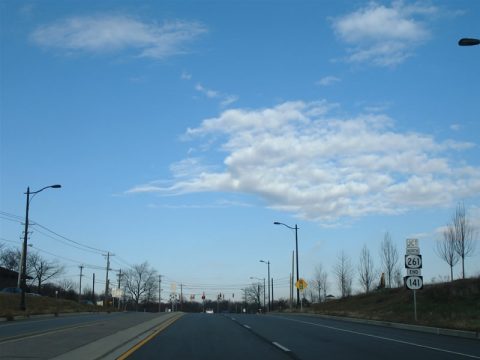
Delaware 141 passes underneath U.S. 202 and ascends to the intersection with Weldon Road. At the traffic light, Delaware 141 ends and Delaware 261 begins and travels northward along Foulk Road, its original alignment.
So the two state routes end at Weldon Road, with Weldon Road serving movements to U.S. 202 north from Foulk Road south and Weldon Road west. There are two end signs for Delaware 141 and a new end sign for Delaware 261 south as well.
Children’s Drive was the connector between Delaware 141 (Powder Mill Road) and Rockland Road. Now the road feeds into Delaware 141’s departure from Powder Mill Road onto “RT 141 Spur”.
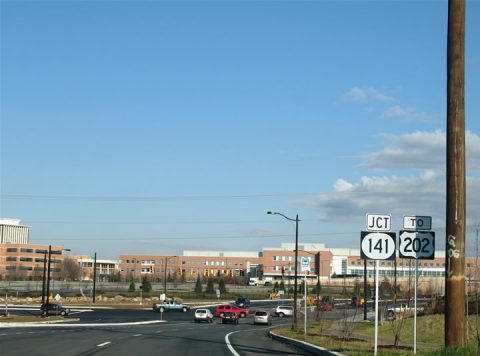
Looking northeastward at that intersection, the original Delaware 141 curved from the left to the right through the Astra Zeneca Campus. Now Powder Mill Road drivers must turn at a pair of turn signals to continue to U.S. 202 at Murphy Road. All others default onto “RT 141 Spur” south to its junction with U.S. 202 near Foulk Road.
Now onto some signing nonsense…
With the $2.7-billion budget shortfall, DelDOT should be cost cutting wherever they can. Part of the reasons for their budget woes is that money for general operating costs comes directly from the budget, which in most states is allocated to highway or mass transit projects, not for standard costs such as paying employee salaries.
I was quite amazed to note a large number of sign replacements throughout northern New Castle County on both area state highways and Interstate 95. Not only are new signs installed everywhere, but the signs installed display exactly the same thing that the editions in which they replaced did! I believe DelDOT was quoted as stating that each sign costs between $25,000 to $50,000 each in 1997, and that cost most certainly has gone up since that time. So with that kind of expenditure, was it necessary to replace 80% of the guide signs along Interstate 95 north from Delaware 141 to U.S. 202 given the fiscal crisis? On top of that, was it justified in doing so given that the new signs display the same information as the 1980s-era signs, and in certain cases, the 1960-era signs?! The original signs were in good shape given their age, so that in and of itself does not justify a replacing. But the information on the signs however did, given that many still use the term “Must Exit” when they should display “Exit Only”. Other signs along Interstate 95 still do not properly reflect the 1984-realignment of U.S. 202 from Wilmington surface streets to the freeway itself. You would think that the new signs would address this issue as well, but that is not the case, as contractors simply placed new signs with the same exact information as the old ones. Furthermore, two 1960s-era signs replaced in 1997 were replaced yet again, and the one for Delaware 4/Exit 6 still references Fourth Street! This project further fuels my doubts as to the efficiency of DelDOT and given their fiscal crisis, continues to justify why the government agency is in trouble.
Let’s take a look:
I took a photo of this same scene last December to show the growing skyline. Much to my amazement, a new high-rise appears in the South Bridge section of Wilmington to the right. Take note of the signs displayed here and compare them to the ones photographed last year. Asides Martin Luther being abbreviated to M.L. and the exit tab being shifted to the right, the signs display the same information as before. “Must Exit” was not properly changed to “Exit Only”, and all state highway and U.S. 202 shields were unfortunately replaced with narrower “Series C” Highway Gothic numbers.
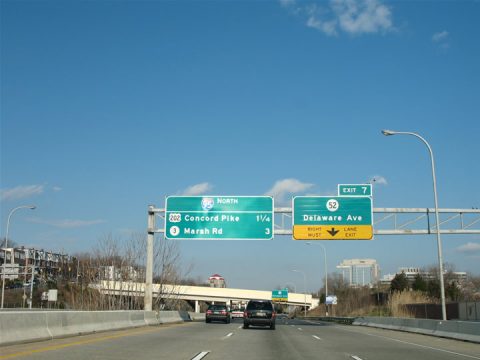
Northbound I-95 leaves the Wilmington Viaduct just ahead of the 6th Street overpass and off-ramp for Delaware 52 (Exit 7).
Here’s another sign change on Interstate 95 northbound at the end of the viaduct portion above 4th Street. Note the “Right Lane Must Exit” which should simply display “Exit Only” and the series C font in “52”. Also note that “Harvey Road – 5” was dropped from the “upcoming exits sign” when comparing with the previous set of signs. Signs for Exit 7 should be changed to reflect 9th Street and Delaware 52/Delaware Avenue. Additionally the interchange sequence signs throughout Interstate 95 in Delaware should be consistent with those used in the rest of the country, such as this sign in Atlanta or as this sign near St. Louis.
In addition to the sign replacement projects, look at this change with amazement! All signs for Interstate 95 & U.S. 202 north at the split with Interstate 495 (unsigned Exit 5D) now include “14 FT Clearance”. I shook my head at this, but do realize why DelDOT slapped that extra bit of signing up there. Twice in 2005, the 10th Street overpass over Interstate 95 in Wilmington was struck by tractor trailers exceeding the maximum height clearance. The National standard of bridge heights on Interstate highways is 16′, but for one reason or another, the 10th Street overpass was built two feet lower. Instead of simply directing vehicles exceeding the height restriction onto the Exit 7 off-ramp and back onto Interstate 95 north via the Adams Street on-ramp north of Delaware Avenue, DelDOT instead tells all over-height truckers to not use any of Interstate 95 west of Interstate 495! Given that I once lived next to U.S. 202 in Talleyville, I know how many trucks use U.S. 202 north into Pennsylvania from Delaware. So this clearance overhead does not address their needs in traveling to/from Pennsylvania via Interstate 95. What should instead be used are signs attached to the Exit 7 off-ramp directing vehicles exceeding the overhead clearance similar to those used at the U.S. 301 interchange in Lumberton, North Carolina where a similar overpass is substandardly low. There truckers simply exit onto the adjacent frontage road and return a short distance later via the next off-ramp. Adams Street acts as a frontage road of Interstate 95 through Wilmington.
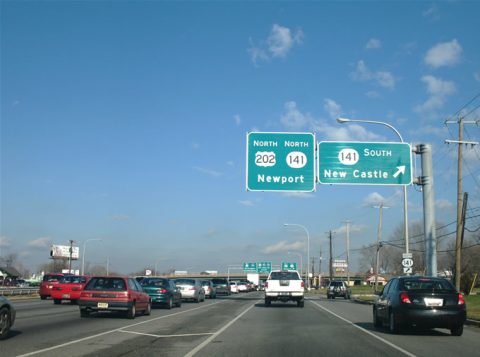
Another bad sign replacement, this time on U.S. 13 north & U.S. 40 east at the U.S. 202 north & Delaware 141 cloverleaf interchange near New Castle. The new signs omit the down facing arrow for U.S. 202 north & Delaware 141 north. They should also reference Wilmington as U.S. 202 north in conjunction with its alignment on Interstate 95 north goes there.
A couple of other changes in the area: The new Churchman’s Road overpass is finally done, and despite me thinking that it was to be four-lanes wide, it only carries two lanes with full shoulders and a bike path. So much for almost two years of work there.
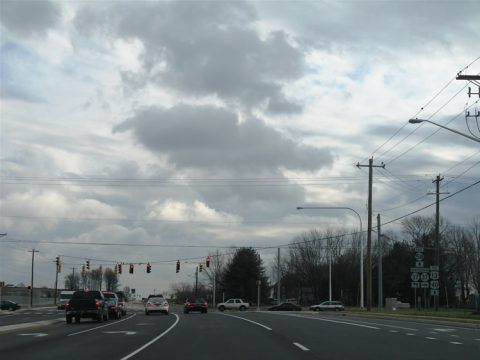
Further east, Delaware 37 and 58’s intersection is now much larger, and it also involves protected turn signals in lieu of doghouses.
So much for being able to determine when its safe to turn on your own; now the traffic light makes those decisions for you. Additionally nearby were mast-arm supported traffic lights at Old Churchman’s Road and Delaware 37 (Airport Road). For one reason or another, those assemblies were replaced with span-wires. Why would DelDOT downgrade mast-arms to span-wires given the durability of mast-arms in wind storms?

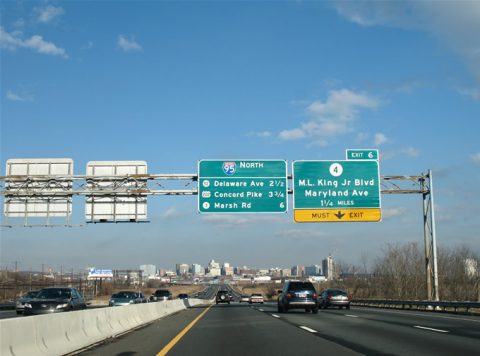
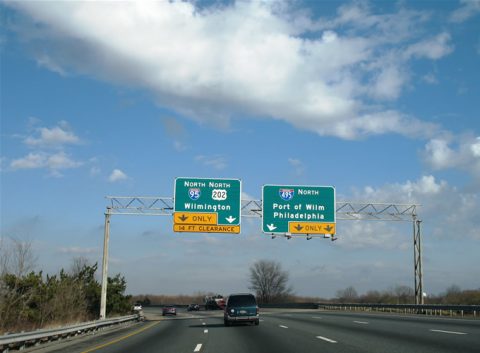
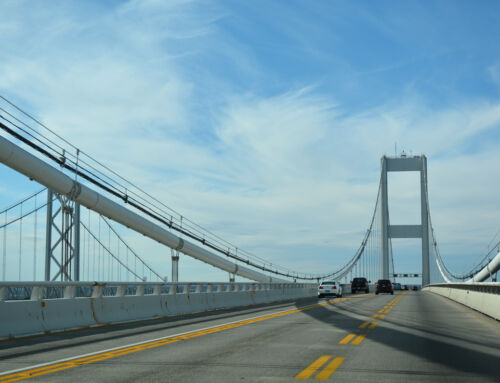
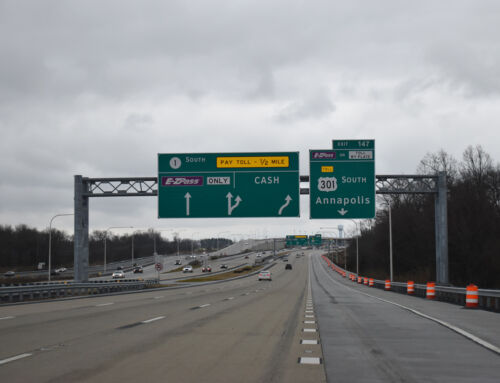
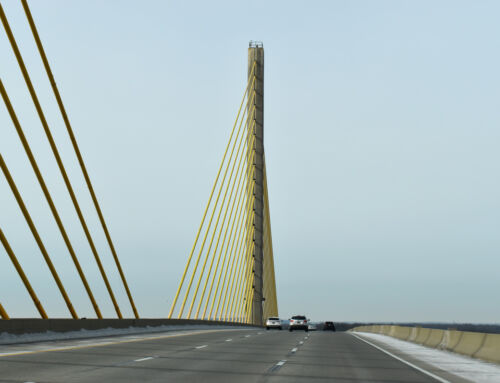
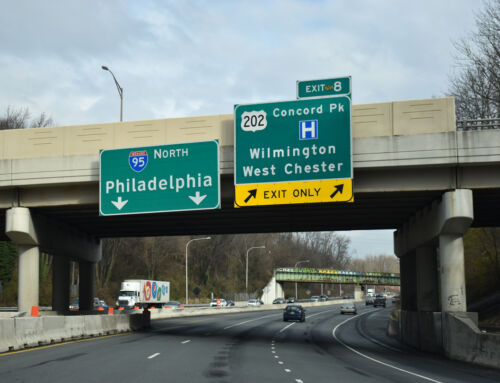
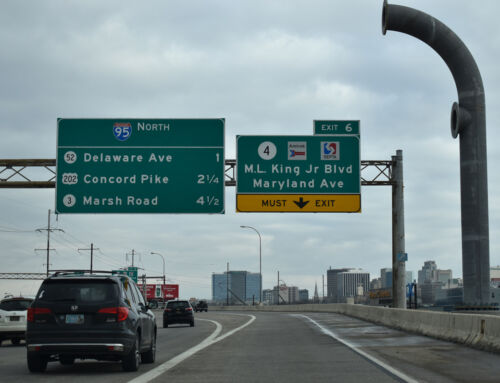
In reference to the signs on I-95, what do the signs for the Route 1 exit say?
Do they say “Dover” yet? The reason I ask is because on Saturday, March 27,
2004, shortly after returning from a trip to Florida, I sent the following
e-mail to public-relations@mail.dot.state.de.us:
Hello. I was driving down I-95 in Delaware a couple of weeks ago, and it
occurred to me that even though Delaware Route 1 has been completed as a freeway
all the way to Dover, the exit signs on I-95 for Route 1 southbound do not say
Dover. In fact, all they say is “Christiana Mall Road,” which I thought was just
a small local road, and the only signs directing drivers to Dover are the ones
for Route 273, which is a bit slow and out of the way. You really should put
“Dover” on the exit signs for Route 1. Please give this some serious
consideration. Thank you very much.
On Tuesday, March 30, 2004, I got the following response from
“Williams, Mike (DelDOT)” :
Mr. Goldman:
I have been able to investigate this concern, as well. At
the request of the Secretary of Transportation there is currently a
comprehensive sign review underway of the sign plans along I-95. The exact
problem you mention is one of the locations that will be changed. The
biggest issue we are wrestling with is that many of the existing signs
cannot handle added pieces, due to their age and locations. So they must be
totally replaced, which involves dedicating money. Plans are underway for
work to begin this summer on a number of sites. Since this is a Dept.
priority changes will happen.
Michael Williams, Community Relations Coordinator
DelDOT Public Relations 302-760-2080
So, I’m just wondering what has occurred in regards to this.
– Mr. Lyle Goldman,
Brooklyn, NY, USA
Drawing closer and closer to three years later, and the signs for Delaware 1 & 7 still display “Christiana” and “Mall Road” (they are supposed to be separate entries, but are placed in a way so that it appears that Delaware 1 & 7 are “Christiana Mall Road”.
I noted that the signs for Delaware 273 still display both “To U.S. 40” and “Dover”, even though they are new replacements! So much for that comprehensive sign review, as those signs are outdated given the fact that they displaed information from before the completion of Delaware 1 at Christiana.
To follow up, on Thursday, December 28, 2006, I sent another e-mail to dot-public-relations@state.de.us:
Hello. It seems that even though Delaware Route 1 has been completed as
a freeway all the way to Dover a few years ago, the exit signs on I-95 for Route
1 southbound do not say Dover. In fact, all they say are “Christiana” and “Mall
Road,” which I thought was just a small local road, and the only signs directing
drivers to Dover are the ones for Route 273, which is a bit slow and out of the
way. Route 1 is the fastest way to Dover from I-95, so you really should put
“Dover” on the exit signs for Route 1. I hear you are in the process of
replacing highway signs throughout I-95 in Delaware, so please give this some
immediate serious consideration. Thank you very much.
I got this response from Bob.King@state.de.us yesterday:
Mr. Goldman,
“Dover” will be included on the I-95 signs for Route 1 (major guide
signs) as part of the I-95 5th Lane Widening Project. That project
starts next year.
Thanks!
Bob King
Robert B. King
Community Relations Officer, PR
Delaware Department of Transportation
(302) 760-2074
– Lyle
The widening of Interstate 95 starts next year? That’s news to me! If you look at their website, the I-95 information is still related to 2004.